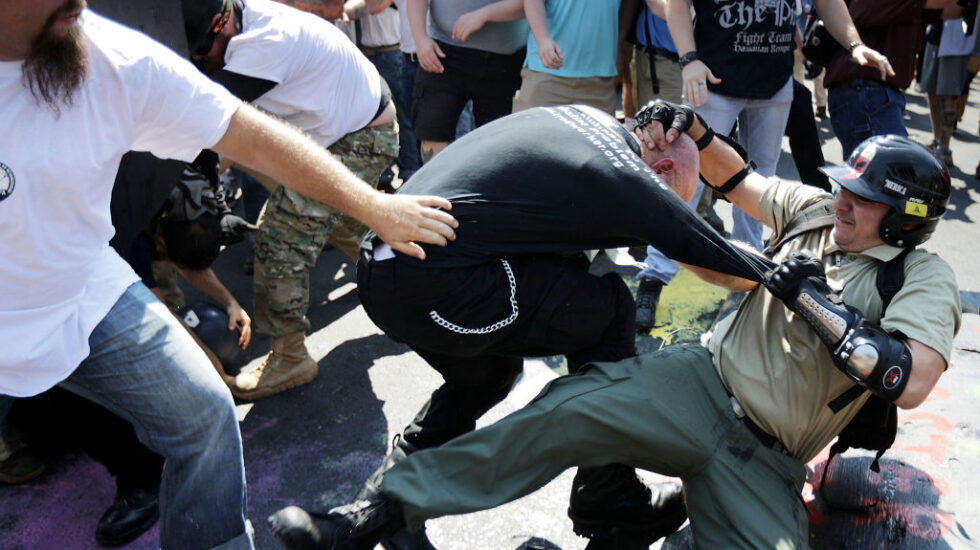Dangerous but inept.
White supremacists are a “leading source of terrorist violence in the US” but the movement is “unable to match its grandiose ambitions,” because of “many weaknesses” according to a new report published by the Brooking Institution.
Scholars Daniel L. Byman and Mark Pitcavage note that white supremacists are “responsible for 40 plots or attacks from 2011 to 2020,” while “right-wing extremists (of all types) in the United States engaged in 98 terrorist incidents” during that same period.
The report claims that President Trump helped create an environment where white supremacists felt emboldened:
President Donald Trump’s rhetoric matched some white supremacist talking points, playing down police violence against Black people,11 calling Mexican immigrants “rapists,” declaring COVID-19 to be a “Chinese virus,” and telling Black and other minority members of Congress to “go back” to their home countries, among many other remarks.
But the report highlights why white supremacists are often unable to advance their agenda. From the Executive Summary:
American white supremacists lack a haven from which to operate; their international ties are also weaker than those of jihadist organizations. The white supremacist movement is also highly divided, and members disagree as to who their primary enemies are and how they should attack them. In addition, they enjoy little public support, and their violence usually backfires, making the movement less popular.
The report says the Deep South is “no longer a major center of white supremacist violence,” as it was during the Jim Crow-era. The movement is both weaker and more diffuse now, meaning there are no power centers where they might enjoy impunity or even support from local law enforcement.
In addition, white supremacists haven’t built a strong network capable of planning a sophisticated attack, unlike Jihadists abroad. The authors add “Like all Americans, white supremacists have easy access to non-automatic firearms, but they cannot easily obtain… military-style forms of weaponry. Nor are skills like bomb-making common within the white supremacist movement, a fact demonstrated by the occasional explosive mishap.” This prevents white supremacist from carrying out attacks with massive body counts like 9/11.
(The report acknowledges “lone wolf” violence that has led to multiple fatalities – like the 2015 Charleston church shooting that left nine dead. But it focuses on the type of coordinated attacks that are indicative of larger terrorists movements.)
Lack of skills and resources, the reports says, makes white supremacist particularly vulnerable to “sting operations, perhaps law enforcement’s most potent tool in fighting domestic terrorism. In a typical sting operation, an informant or undercover officer purports to offer the subject some means, such as explosives or weapons, that they seek in order to carry out their plans. A subject who goes through with such a deal can be arrested.”
Another issue for white supremacists: they have too many enemies, making an internal consensus on who they should target difficult. In other words, they struggle to “focus and prioritize” their “limited resources.” Plus, their long list of potential targets – ranging from Blacks and Jews to members of the Arab and LGBTQ communities – can rally together to pressure a government crackdown.
Byman and Pitcavage make a number of recommendations to take advantage of the weaknesses in the white supremacist movement, including close monitoring of known white supremacist social media accounts: “White supremacist recruiting can often be vulnerable to tracking. Recruiting, at least in its initial stages, is usually done openly, often via social media.”
The authors add that many white supremacist have criminals records – ranging from drug abuse to domestic violence – and can therefore be “flipped” to inform on their peers.
The report concludes that following the Trump administration’s “ambiguous signals” about white supremacy, a full-throated condemnation of the movement from the upper echelons of U.S. government is important:
High-level support for cracking down on white supremacist violence will ensure that resources are in place to fight white supremacists, that agencies know their roles, and that more mainstream groups that are critical of immigration or otherwise share some concerns of white supremacists know they must reject the violent haters in their ranks.



